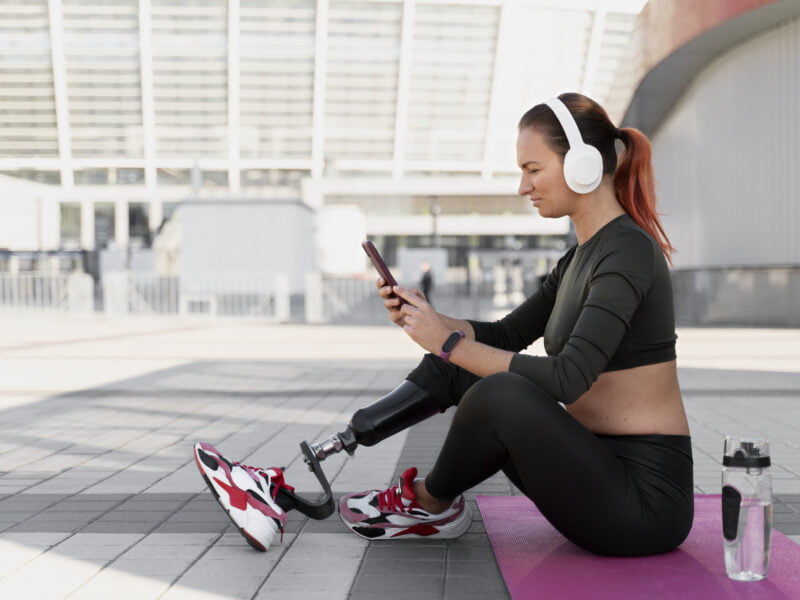Somatic exercises are not a cure for anxiety, they are like a catalyst that speeds up the process alongside therapy. These exercises use your body movements to balance your mind and body, relieving stress and anxiety. Not just that, somatic exercises also have other benefits like body alignment and pain relief.
So if you want to improve your mental health and effectively manage your anxiety, here we bring you the 5 best somatic exercises for anxiety.
What are Somatic Exercises?
Somatic exercises are a type of movement therapy that focuses on internal physical perception and experience to improve physical function and relieve anxiety and pain. These exercises aim to enhance body awareness and help you become more receptive to the sensations and movements within your body. Somatic exercises for anxiety typically involve slow, gentle, and deliberate movements to explore and understand the body’s natural range of motion without causing any strain or discomfort.
Somatic exercises for trauma also retrain your body to move more efficiently and comfortably by correcting habitual movement patterns when combined with the right diet like the 30 30 30 approach, contributing to mental stress, pain, or dysfunction.
Anxiety somatic exercises can be beneficial for a wide range of people, including those recovering from traumatic injuries, dealing with chronic pain, or seeking to improve their overall mental and physical health.
How can Somatic Exercises Help Relieve Stress & Anxiety?
When a person experiences stress or anxiety, the body undergoes several physiological changes, driven by the activation of the sympathetic nervous system (SNS) and the release of stress hormones like cortisol and adrenaline. These changes are part of the body’s “fight or flight” response.
Anxiety often leads to increased heart rate and blood pressure, increased muscle tension, etc. It is fair to say that anxiety causes a person not only mental harm but also affects one’s physical health. So how do somatic exercises help relieve this stress and anxiety?
Here’s how:
Activating the Parasympathetic Nervous System (PNS):
Somatic exercises for anxiety promote deep, diaphragmatic breathing which can help activate the PNS. This is the “rest and digest” system that counteracts the fight-or-flight response.Reducing Muscle Tension:
Focusing on bodily sensations and performing slow, controlled movements, somatic exercises to release trauma can help individuals become aware of areas of chronic tension and gradually release it.Better Breathing Patterns:
Many somatic anxiety reduction techniques include a focus on breathing. Slow, deep breathing helps increase oxygen flow, promotes relaxation, and reduces the physical symptoms of anxiety such as rapid heart rate and dizziness.Enhancing Body Awareness:
Helps recognize early signs of stress and anxiety and enables you to take proactive steps to manage your stress, trauma, and anxiety.Releasing Emotional Tension:
Emotions are often stored in the body as physical tension. By engaging in somatic exercises for anxiety, individuals can release these stored emotions.Specific Ways Somatic Exercises Help To Relieve Anxiety
Feldenkrais Method:
Through gentle movements and attention to how these movements feel, the Feldenkrais Method can help individuals break habitual patterns of tension, stress, and anxiety and improve overall body mechanics.Alexander Technique:
This somatic anxiety reduction technique teaches improved posture and movement efficiency, which can minimize physical strain and reduce the physical symptoms of anxiety.Hanna Somatics:
Focuses on sensory-motor awareness to identify and release chronic muscle contractions, which can be a physical manifestation of stress.Continuum Movement:
Involves fluid, wave-like movements that help release tension and foster a sense of inner peace and connection, thereby reducing anxiety, stress, and trauma.5 Best Somatic Exercises For Anxiety & Mental Health Improvement

1. Belly Breathing or Diaphragmatic Breathing
Diaphragmatic breathing, also known as belly breathing, involves deep breathing that fully engages the diaphragm, allowing your lungs to take in more oxygen. This breathing technique can also help you get rid of your hanging belly.
How to Do It:
- Sit or lie down in a comfortable position.
- Place one hand on your chest and the other on your belly.
- Inhale deeply through your nose, allowing your belly to rise as it fills with air.
- Exhale slowly through your mouth, letting your belly fall.
- Repeat for 5-10 minutes, focusing on the rise and fall of your belly.
2. Progressive Muscle Relaxation
Progressive muscle relaxation is an anxiety reduction somatic workout that involves tensing and then slowly relaxing each muscle group in the body, helping to reduce physical tension and promote relaxation.
How to Do It:
- Find a comfortable position, either sitting or lying down.
- Start with your feet, tensing the muscles as tightly as you can for 5-10 seconds.
- Slowly release the tension, focusing on the sensation of relaxation.
- Move up through each muscle group.
3. Body Scan Meditation
Body scan meditation is a somatic workout for anxiety that focuses attention on different parts of the body, promoting body awareness.
How to Do It:
- Lie down in a comfortable position.
- Close your eyes and take a few deep breaths to relax.
- Begin by focusing your attention on your toes, noticing any sensations without judgment.
- Slowly move your focus up your body.
- Continue until you have scanned your entire body.
4. Yoga or Tai Chi
Somatic exercises for anxiety and effective weight loss like yoga and Tai Chi use slow, deliberate movements combined with deep breathing and focused attention to enhance the mind-body connection.
How to Do It:
- Choose a simple yoga or Tai Chi somatic routine.
- Focus on the movements and how your body feels as you perform them.
- Synchronize your breathing with your movements.
- Pay attention to the sensations in your muscles, joints, and throughout your body.
- Practice regularly, even for just 10-15 minutes a day.
5. Grounding Exercises
This somatic exercise for trauma release and anxiety helps anchor you in the present moment, reducing anxiety and inducing a sense of stability and calm.
How to Do It:
- Sit comfortably with your feet flat on the ground.
- Focus on the feeling of your feet making contact with the ground.
- Pay attention to the sensations in your feet and legs.
- Imagine roots growing from your feet into the earth, providing stability and support.
- Take deep, slow breaths as you maintain this focus.
Final Takeaway
You need to understand that while these exercises are a great at-home way to reduce your stress level and trauma, these somatic workout techniques can not replace therapy.
So, if you’re going through some stress or anxiety, it is best to see a professional while you also make the above somatic routines a part of your life.






2 Comments